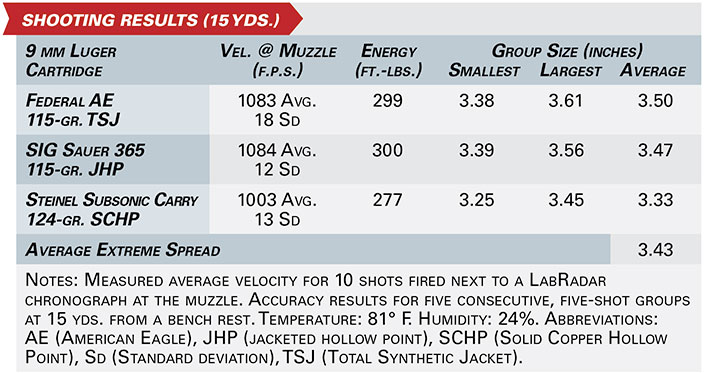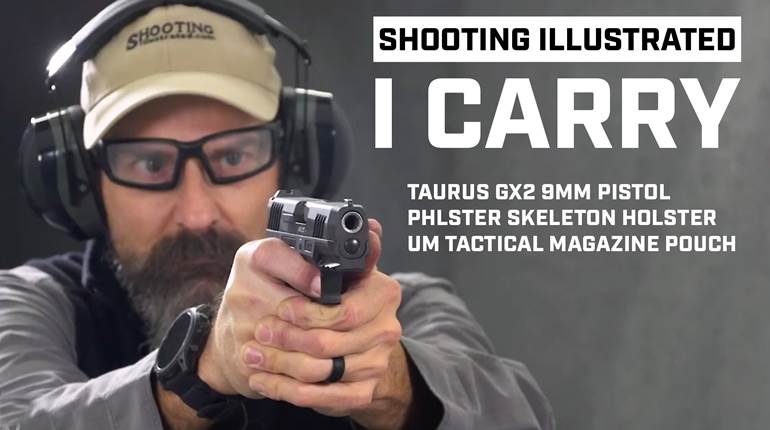
Last year, Taurus clearly demonstrated its renewed commitment to manufacturing practical, affordable handguns with consistent quality control. New options included the American-made TX22 rimfire pistol, lightweight versions of the six-shot Model 856 carry revolver and the G3 9 mm Luger pistol. The 4"-barreled, double-stack G3 built on the success of previous G-series models with an improved trigger system and modified slide profile. With its new subcompact G3c, Taurus didn’t settle for just making the gun smaller, it incorporated improvements to the slide, sights and controls.
Manufactured in Brazil, the G3c is a polymer-frame, striker-fired semi-automatic employing a short-recoil, locked-breech action. With a design that is clearly based on its predecessor, the G2c, this latest pistol offers a magazine with a standard capacity of 12 rounds of 9 mm Luger. With external dimensions comparable to those of the Glock G26, it’s easy to find suitable holsters for comfortable concealment, such as the DeSantis Inner Piece 2.0 inside-the-waistband holster.
The carbon steel slide is treated with a Tenifer finish, which has a proven history of resistance to scratches, wear and corrosion. The deep front cutouts of the G2-style slide have been replaced with a squared-off profile that allows for front and rear canted cocking serrations. This is a plus for those who prefer to manipulate the slide from the front end. The slide’s nose is beveled for easier re-holstering, while the back end is nicely rounded to match the contours of the frame.

The polymer sights have been replaced with an all-steel sight system. The white-dot front sight is paired with a serrated square-notch rear sight dovetailed into the slide so as to be drift-adjustable. Taurus recognizes that many concealed carry practitioners are swapping out factory iron sights for fiber-optics or night sights. To make this process easier for customers, the G3c’s dovetail and front sight port are compatible with sight upgrades made for Glock pistols.
The bore of the 3.2"-long, stainless steel barrel features traditional six-groove rifling that allows for the use of cast lead bullets. The top of the chamber has a witness hole that takes the place of the mechanical chamber indicator found on the G2c. It allows the state of the chamber to be verified without retracting the slide. The feed ramp is polished mirror-smooth for reliable feeding. The two-piece, dual recoil spring assembly uses all-steel supports instead of a mix of steel and polymer as in some models. It provides plenty of support while allowing the slide to be manually cycled with ease. Although the effort required to rack the slide is greater than for Smith & Wesson’s M&P9 Shield EZ 9 mm (I had one on hand for comparison), it’s not too much more.

The slide rides on four short rails that project from steel front and rear support blocks secured to the frame with roll pins. The pistol’s serial number can be found in no less than four locations. It’s stamped to the front support block and can be seen through a left-side cutout in the polymer frame. Another is located in a metal plate molded into the dustcover, with the remaining two found on the barrel and slide next to the ejection port. The external controls, including the takedown lever, slide stop, magazine release button and the thumb safety are all metal, not polymer. Like the slide, these controls now have an upgraded finish; they’ve been treated with black Teflon, which is not only corrosion-resistant but also increases lubricity for smoother operation.
The left-side thumb safety lever has an unobtrusive low profile that won’t dig into your hip when holstered. It swings up into the “safe” position and down, exposing a red dot on the slide, to fire. It shifts positions after a modest amount of pressure with distinctive clicks when it locks into either setting. The magazine release has a serrated surface for improved purchase, and it can be reversed for left-handers.
Like the slide, all of the frame’s edges have been rounded for a sleek appearance and comfortable feel. The dustcover sports a molded-in 1.25"-long, one-slot accessory rail. Just behind the rail are left- and right-side indentations (Taurus calls them “Memory Pads”) that act as touch points for the tip of the trigger finger when resting it against the frame. The trigger guard is curved and rounded along the front edge, to serve as a support hand/finger rest, and undercut where it meets the grip for added comfort.
One of the reasons striker-fired pistols have become so popular is because of the consistent trigger pulls they provide. But not all striker triggers are created equal—some have a mushy, indistinct feel. The G3 series was released with a new trigger system that felt like it belongs on a more expensive pistol. The face of the trigger is grooved and flattened with a wide, integrated safety lever. It has a light 2-lb. takeup with a firm stop before breaking cleanly at 4 lbs., 10 ozs.
The trigger comes to rest against the frame and only needs about a 1/4" release in order to reset. The result is a trigger that feels tuned instead of factory-installed, and its short reset aids in quick follow-up shots. This pistol’s ignition system also provides second-strike capability. This means that should the firing pin strike a hard primer, the trigger can be pulled a second time to strike it again. That feature is not available on many striker-fired pistols.

Some polymer-frame guns suffer from bulky or blocky feeling grips. Taurus went out of its way with the G3 grip frame to make sure it would be a comfortable fit for a variety of hand shapes. Although the G3c’s frame is shorter, the company was careful to preserve the positive grip characteristics of the larger version.
At the top of the grip, on both sides, are ridged depressions that act a thumb rests. The G3c does not have interchangeable backstraps, but I still found the grip to be a comfortable size and shape for my somewhat smaller hands. Some pistol grips feature a moderate texture applied to most of the surface area, but Taurus opted for an all-or-nothing approach. The surfaces of the G3c’s grip are smooth with the exception of six molded-in textured panels that provide added purchase to all four sides of the frame.
The texturing of these panels is aggressive, with rough-grit feel comparable to skateboard tape or sandpaper, but it’s isolated to those points along the shooting hand palm and fingers where added control is most useful. The textured portions can feel abrasive during extended practice sessions at the shooting range; I chose to put on a shooting glove after a while during the range test. That said, it provides plenty of purchase for less than ideal circumstances. During a defensive situation we may be wearing gloves or our hands may be wet or cold, and its in circumstances such as these where this kind of texturing is most useful.
The grip’s backstrap extends down behind the baseplate of the blued steel, double-stack magazine. This helps to protect the shooting hand from getting pinched during reloads and prevents the baseplate from nibbling at the palm when the pistol recoils. The magazine well and polymer baseplates of the 12-round magazines share matching dimples on both sides. This provides for a better grip on the baseplate should the magazine need to be manually stripped out of the grip due to fouling or other malfunction. The baseplate is also flared along the front edge to provide a rest for the little finger. This pistol’s internal and external safeties include a manual safety lever, the trigger safety and a firing pin block. The G3c does not have a magazine safety, which means the pistol will fire if the trigger is depressed, even with the magazine removed.

Breaking down the G3c for routine cleaning follows a similar set of steps as other striker-fired pistols. Start by removing the magazine, opening the action and verifying that the pistol is completely unloaded. Then close the action. Retract the slide about 0.25" and then hold it in that position while pulling down on the takedown lever. Release the slide and then press the trigger. The slide can now be pressed forward off of the frame. Remove the recoil assembly and barrel from the interior of the slide and the pistol is ready to clean.
The production-grade G3 I worked with last year arrived in great shape. The overall fit and finish was top-notch. The metal finishes were properly applied, the gun was clean inside and out and shipped without any of the scratches and blemishes that I’ve seen on some Taurus products in the past. The slide and frame were both well made and free of machine or mold marks. The controls all worked smoothly and properly. Taurus has suffered from quality-control issues in the past, but I’m glad to report that the G3c was just as healthy of a specimen as the G3. In fact, both pistols exhibited the same clean, consistent 4-lb., 10-oz., trigger pull.
At the shooting range, the G3c proved to be utterly reliable with all of the test ammunition fired, including practice-grade and premium, defensive hollow-point loads. The pistol was mechanically sound as well, with the controls and all three magazines operating properly. The magazine release is well-positioned to be easy to reach, and the magazines dropped free from the grip when the release was pressed. Small 9 mm pistols such as this one can produce snappy levels of felt recoil depending on the loads selected, but the rounded, hand-filling, three-finger grip and grip texturing makes this pistol more manageable than some. According to the owner’s manual, the G3c is safe to fire with SAAMI-rated +P ammunition.

With the release of the new Taurus G3c, I was hoping to see the same level of commitment to consistent quality control, reliability and value that I found in the G3. But Taurus insisted on one-upping itself by giving the slide a Tenifer finish, weatherproofing the controls and configuring the sight system to accept readily available Glock-type upgrades.
The factory trigger feels like an upgrade as well, thanks to its light takeup and short reset. The defensive accuracy is where it needs to be with group averages hovering around 3.5" at 15 yds. With these upgrades and a suggested retail price of $306, the G3c is well-positioned to compete with popular concealed carry 9 mm Luger pistols that cost more while offering a budget-friendly price tag.







































